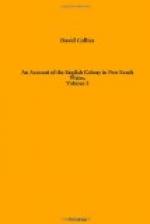Although he had seen but few of the low islands of Furneaux, yet Mr. Bass had not any doubt but that this account of Preservation Island would in general answer for the description of any of them.
He next proceeds to describe what little he saw of Cape Barren Island, which he understood, from the people of the Nautilus snow, who had been there sealing, was an exact specimen of those of the higher kind, so far as they had observed of them.
Cape Barren Island, which takes its name from the cape so called by Captain Furneaux, is a small island when compared with that lying to the northward of it. From what was seen of it in the sloop, it could only be conjectured that these two were separate islands; but Mr. Bishop had passed in the Nautilus through the channel that divides them.
Mr. Bass did not land upon the large island, and it is only of the southern end of Cape Barren Island that he could speak from his own particular observation.
This island is one of those of the higher kind that consist of both high and low land. The high part is composed of granite, in many places almost bare, in others poorly clothed with moderate sized gum trees, which draw their support through some small quantity of vegetable earth lodged by the broken blocks and fragments of the stone, and some straggling brush-wood shooting up round the trees, and completing the appearance of a continued vegetation.
The base of the low part is granite; its surface chiefly sand; its produce, variety of brush, with some few small gum trees, and a species of fir, that grows tall and straight to the height of 20 or 25 feet. There are within the body of the brush several clear spots, where the ground is partly rocky or sandy, partly wet and spongy. These are somewhat enlivened by beautiful flowering heath, and low shrubs, but have upon the whole a dark sombrous aspect, too much resembling the barren heaths of Hampshire.
A grass tree grows here, similar in every respect to that about Port Jackson, except that no reed, neither living nor dead, could be found to belong to it. It is certain, however, that there must be a reed, or a flowering part of some kind. In the brushes, where the sandy soil is somewhat ameliorated by the decay of vegetation, a few tufts of indifferent grass might be seen; but the greater part of it was the coarse wiry sort that grows in hassocks.
It is singular, that a place wherein food seemed to be so scarce should yet be so thickly inhabited by the small brush kangaroo, and a new quadruped, which was also a grass-eater.
This animal, being a new one, appears to deserve a particular description. The Wombat (or, as it is called by the natives of Port Jackson, the Womback) is a squat, thick, short-legged, and rather inactive quadruped, with great appearance of stumpy strength, and somewhat bigger than a large turnspit dog. Its figure and movements, if they do not exactly resemble those of the bear, at least strongly remind one of that animal.




